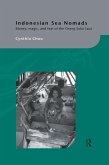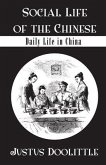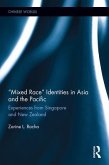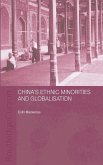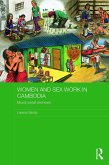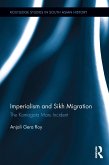L Richmond Wheeler
The Modern Malay
L Richmond Wheeler
The Modern Malay
- Gebundenes Buch
- Merkliste
- Auf die Merkliste
- Bewerten Bewerten
- Teilen
- Produkt teilen
- Produkterinnerung
- Produkterinnerung
First published in 1928, this book us a very complete survey of the Malay Peninsula, its physical aspects, its history, laws government, and present day problems; while a large part of the book is devoted to a study of the Malay himself.
Andere Kunden interessierten sich auch für
![Indonesian Sea Nomads Indonesian Sea Nomads]() Cynthia ChouIndonesian Sea Nomads197,99 €
Cynthia ChouIndonesian Sea Nomads197,99 €![Social Life of the Chinese Social Life of the Chinese]() Justus DoolittleSocial Life of the Chinese262,99 €
Justus DoolittleSocial Life of the Chinese262,99 €![Mixed Race Identities in Asia and the Pacific Mixed Race Identities in Asia and the Pacific]() Zarine L RochaMixed Race Identities in Asia and the Pacific131,99 €
Zarine L RochaMixed Race Identities in Asia and the Pacific131,99 €![China's Ethnic Minorities and Globalisation China's Ethnic Minorities and Globalisation]() Colin MackerrasChina's Ethnic Minorities and Globalisation250,99 €
Colin MackerrasChina's Ethnic Minorities and Globalisation250,99 €![Women and Sex Work in Cambodia Women and Sex Work in Cambodia]() Larissa SandyWomen and Sex Work in Cambodia200,99 €
Larissa SandyWomen and Sex Work in Cambodia200,99 €![Internet Video Culture in China Internet Video Culture in China]() Marc L MoskowitzInternet Video Culture in China197,99 €
Marc L MoskowitzInternet Video Culture in China197,99 €![Imperialism and Sikh Migration Imperialism and Sikh Migration]() Anjali RoyImperialism and Sikh Migration197,99 €
Anjali RoyImperialism and Sikh Migration197,99 €-
-
-
First published in 1928, this book us a very complete survey of the Malay Peninsula, its physical aspects, its history, laws government, and present day problems; while a large part of the book is devoted to a study of the Malay himself.
Hinweis: Dieser Artikel kann nur an eine deutsche Lieferadresse ausgeliefert werden.
Hinweis: Dieser Artikel kann nur an eine deutsche Lieferadresse ausgeliefert werden.
Produktdetails
- Produktdetails
- Verlag: Taylor & Francis
- Seitenzahl: 300
- Erscheinungstermin: 16. April 2019
- Englisch
- Abmessung: 216mm x 140mm x 19mm
- Gewicht: 517g
- ISBN-13: 9780367179069
- ISBN-10: 0367179067
- Artikelnr.: 56881406
- Herstellerkennzeichnung
- Libri GmbH
- Europaallee 1
- 36244 Bad Hersfeld
- gpsr@libri.de
- Verlag: Taylor & Francis
- Seitenzahl: 300
- Erscheinungstermin: 16. April 2019
- Englisch
- Abmessung: 216mm x 140mm x 19mm
- Gewicht: 517g
- ISBN-13: 9780367179069
- ISBN-10: 0367179067
- Artikelnr.: 56881406
- Herstellerkennzeichnung
- Libri GmbH
- Europaallee 1
- 36244 Bad Hersfeld
- gpsr@libri.de
L. Richmond Wheeler
Part 1: Introductory 1. First impressions 2. Physical Features of Malaya 3.
Political Part 2: Early Influences (Up to A.D 1874) 1. Ethnography (i)
Races in the Peninsula (ii) Allied Races of the Malay Archipelago (iii)
Language (iv) The Origin of the Malays (v) Physical Qualities of the
Peninsular Malay 2. Early History: Up to AD. 1400 3. Malay Ascendancy: AD.
1400-1511 4. Malay Decline: AD. 1511-1874 (i) The Malay States (ii) Alien
Invaders (European) (iii) Alien Invaders (Asiatic) (iv) Summary of the
Period 5. Early Malay Beliefs and Character (i) Primitive Culture (ii)
Islam and the Sultanate (iii) The Menangkabau Tradition: Malay Law Part 3:
Recent Influences (From AD. 1874) 1. General Condition of the Malays at the
Beginning of this Period (i) General Decadence (ii) Piracy (iii) The
Chinese Invasion (iv) Larut 2. Early British Influence in the Peninsula (i)
Before A.D. 1874 3. Influence in Recent Times of Other Races 4. Later
Effects of British Influence (i) The Work of British Officals (ii)
Prosperity of the Country (iii) Malay Affairs Part 4: Present Conditions
1. Land Policy 2. Education (i) General (ii) Malay Education in the
Vernacular (iii) English Education (iv) Higher Education (v) Education for
Girls 3. Special Opportunities for Malays 4. Contact with Europeans (i) The
Old Traditions (ii) Present Familiarity 5. The Cinematograph 6. Asia and
Modern Islam (i) The Changing Outlook (ii) The Religious Revival (iii)
Racial Ideas 7. The Unfederated States (i) General (ii) Johore (iii) The
Northern States (iv) Brunei Part 5: The Present Response 1. Malay ''Types''
(i) The Peasant or 'Rayat' Class (ii) The Noble or 'Raja' Class (iii) The
Growth of a Middle Class 2. General Characteristics Part 6: The Future of
the Peninsular Malays 1. The necessity for a Sense of Proportion 2. The
Clash of Ideas (i) Political (ii) Racial and National (iii) Religious;
Islamic and Non-Islamic 3. Developments in Education (i) Malay Education
(ii) English Education; Special Facilities for Malays; Certain Factors in
the Curriculum (iii) Moral Education 4. Developments in General Culture (i)
Preliminary (ii) Forces of Inertia (iii) The Position of Women (iv) The
Development of Malay Industries; Handicrafts, Agriculture, Fisheries,
Jungle Produce, Conclusion 5. Health and Racial Progress (i) Introductory
(ii) A Dying Stock? (iii) Lack of Vitality (iv) Improvements: Present and
Future (v) A Hopeful Outlook 6. Conclusions (i) Is it Worthwhile Fostering
the Malays? (ii) Exploitation (iii) The Future of the Malays; The
Population Factor; Dependence on British Co-operation (iv) Sundry Problems
Common to Malaya and the Rest of the World; Natural Resources; Empty
Spaces; Order of Anarchy, Peace and Prosperity, Capitalism, State Control
(v) British Imperialism
Political Part 2: Early Influences (Up to A.D 1874) 1. Ethnography (i)
Races in the Peninsula (ii) Allied Races of the Malay Archipelago (iii)
Language (iv) The Origin of the Malays (v) Physical Qualities of the
Peninsular Malay 2. Early History: Up to AD. 1400 3. Malay Ascendancy: AD.
1400-1511 4. Malay Decline: AD. 1511-1874 (i) The Malay States (ii) Alien
Invaders (European) (iii) Alien Invaders (Asiatic) (iv) Summary of the
Period 5. Early Malay Beliefs and Character (i) Primitive Culture (ii)
Islam and the Sultanate (iii) The Menangkabau Tradition: Malay Law Part 3:
Recent Influences (From AD. 1874) 1. General Condition of the Malays at the
Beginning of this Period (i) General Decadence (ii) Piracy (iii) The
Chinese Invasion (iv) Larut 2. Early British Influence in the Peninsula (i)
Before A.D. 1874 3. Influence in Recent Times of Other Races 4. Later
Effects of British Influence (i) The Work of British Officals (ii)
Prosperity of the Country (iii) Malay Affairs Part 4: Present Conditions
1. Land Policy 2. Education (i) General (ii) Malay Education in the
Vernacular (iii) English Education (iv) Higher Education (v) Education for
Girls 3. Special Opportunities for Malays 4. Contact with Europeans (i) The
Old Traditions (ii) Present Familiarity 5. The Cinematograph 6. Asia and
Modern Islam (i) The Changing Outlook (ii) The Religious Revival (iii)
Racial Ideas 7. The Unfederated States (i) General (ii) Johore (iii) The
Northern States (iv) Brunei Part 5: The Present Response 1. Malay ''Types''
(i) The Peasant or 'Rayat' Class (ii) The Noble or 'Raja' Class (iii) The
Growth of a Middle Class 2. General Characteristics Part 6: The Future of
the Peninsular Malays 1. The necessity for a Sense of Proportion 2. The
Clash of Ideas (i) Political (ii) Racial and National (iii) Religious;
Islamic and Non-Islamic 3. Developments in Education (i) Malay Education
(ii) English Education; Special Facilities for Malays; Certain Factors in
the Curriculum (iii) Moral Education 4. Developments in General Culture (i)
Preliminary (ii) Forces of Inertia (iii) The Position of Women (iv) The
Development of Malay Industries; Handicrafts, Agriculture, Fisheries,
Jungle Produce, Conclusion 5. Health and Racial Progress (i) Introductory
(ii) A Dying Stock? (iii) Lack of Vitality (iv) Improvements: Present and
Future (v) A Hopeful Outlook 6. Conclusions (i) Is it Worthwhile Fostering
the Malays? (ii) Exploitation (iii) The Future of the Malays; The
Population Factor; Dependence on British Co-operation (iv) Sundry Problems
Common to Malaya and the Rest of the World; Natural Resources; Empty
Spaces; Order of Anarchy, Peace and Prosperity, Capitalism, State Control
(v) British Imperialism
Part 1: Introductory 1. First impressions 2. Physical Features of Malaya 3.
Political Part 2: Early Influences (Up to A.D 1874) 1. Ethnography (i)
Races in the Peninsula (ii) Allied Races of the Malay Archipelago (iii)
Language (iv) The Origin of the Malays (v) Physical Qualities of the
Peninsular Malay 2. Early History: Up to AD. 1400 3. Malay Ascendancy: AD.
1400-1511 4. Malay Decline: AD. 1511-1874 (i) The Malay States (ii) Alien
Invaders (European) (iii) Alien Invaders (Asiatic) (iv) Summary of the
Period 5. Early Malay Beliefs and Character (i) Primitive Culture (ii)
Islam and the Sultanate (iii) The Menangkabau Tradition: Malay Law Part 3:
Recent Influences (From AD. 1874) 1. General Condition of the Malays at the
Beginning of this Period (i) General Decadence (ii) Piracy (iii) The
Chinese Invasion (iv) Larut 2. Early British Influence in the Peninsula (i)
Before A.D. 1874 3. Influence in Recent Times of Other Races 4. Later
Effects of British Influence (i) The Work of British Officals (ii)
Prosperity of the Country (iii) Malay Affairs Part 4: Present Conditions
1. Land Policy 2. Education (i) General (ii) Malay Education in the
Vernacular (iii) English Education (iv) Higher Education (v) Education for
Girls 3. Special Opportunities for Malays 4. Contact with Europeans (i) The
Old Traditions (ii) Present Familiarity 5. The Cinematograph 6. Asia and
Modern Islam (i) The Changing Outlook (ii) The Religious Revival (iii)
Racial Ideas 7. The Unfederated States (i) General (ii) Johore (iii) The
Northern States (iv) Brunei Part 5: The Present Response 1. Malay ''Types''
(i) The Peasant or 'Rayat' Class (ii) The Noble or 'Raja' Class (iii) The
Growth of a Middle Class 2. General Characteristics Part 6: The Future of
the Peninsular Malays 1. The necessity for a Sense of Proportion 2. The
Clash of Ideas (i) Political (ii) Racial and National (iii) Religious;
Islamic and Non-Islamic 3. Developments in Education (i) Malay Education
(ii) English Education; Special Facilities for Malays; Certain Factors in
the Curriculum (iii) Moral Education 4. Developments in General Culture (i)
Preliminary (ii) Forces of Inertia (iii) The Position of Women (iv) The
Development of Malay Industries; Handicrafts, Agriculture, Fisheries,
Jungle Produce, Conclusion 5. Health and Racial Progress (i) Introductory
(ii) A Dying Stock? (iii) Lack of Vitality (iv) Improvements: Present and
Future (v) A Hopeful Outlook 6. Conclusions (i) Is it Worthwhile Fostering
the Malays? (ii) Exploitation (iii) The Future of the Malays; The
Population Factor; Dependence on British Co-operation (iv) Sundry Problems
Common to Malaya and the Rest of the World; Natural Resources; Empty
Spaces; Order of Anarchy, Peace and Prosperity, Capitalism, State Control
(v) British Imperialism
Political Part 2: Early Influences (Up to A.D 1874) 1. Ethnography (i)
Races in the Peninsula (ii) Allied Races of the Malay Archipelago (iii)
Language (iv) The Origin of the Malays (v) Physical Qualities of the
Peninsular Malay 2. Early History: Up to AD. 1400 3. Malay Ascendancy: AD.
1400-1511 4. Malay Decline: AD. 1511-1874 (i) The Malay States (ii) Alien
Invaders (European) (iii) Alien Invaders (Asiatic) (iv) Summary of the
Period 5. Early Malay Beliefs and Character (i) Primitive Culture (ii)
Islam and the Sultanate (iii) The Menangkabau Tradition: Malay Law Part 3:
Recent Influences (From AD. 1874) 1. General Condition of the Malays at the
Beginning of this Period (i) General Decadence (ii) Piracy (iii) The
Chinese Invasion (iv) Larut 2. Early British Influence in the Peninsula (i)
Before A.D. 1874 3. Influence in Recent Times of Other Races 4. Later
Effects of British Influence (i) The Work of British Officals (ii)
Prosperity of the Country (iii) Malay Affairs Part 4: Present Conditions
1. Land Policy 2. Education (i) General (ii) Malay Education in the
Vernacular (iii) English Education (iv) Higher Education (v) Education for
Girls 3. Special Opportunities for Malays 4. Contact with Europeans (i) The
Old Traditions (ii) Present Familiarity 5. The Cinematograph 6. Asia and
Modern Islam (i) The Changing Outlook (ii) The Religious Revival (iii)
Racial Ideas 7. The Unfederated States (i) General (ii) Johore (iii) The
Northern States (iv) Brunei Part 5: The Present Response 1. Malay ''Types''
(i) The Peasant or 'Rayat' Class (ii) The Noble or 'Raja' Class (iii) The
Growth of a Middle Class 2. General Characteristics Part 6: The Future of
the Peninsular Malays 1. The necessity for a Sense of Proportion 2. The
Clash of Ideas (i) Political (ii) Racial and National (iii) Religious;
Islamic and Non-Islamic 3. Developments in Education (i) Malay Education
(ii) English Education; Special Facilities for Malays; Certain Factors in
the Curriculum (iii) Moral Education 4. Developments in General Culture (i)
Preliminary (ii) Forces of Inertia (iii) The Position of Women (iv) The
Development of Malay Industries; Handicrafts, Agriculture, Fisheries,
Jungle Produce, Conclusion 5. Health and Racial Progress (i) Introductory
(ii) A Dying Stock? (iii) Lack of Vitality (iv) Improvements: Present and
Future (v) A Hopeful Outlook 6. Conclusions (i) Is it Worthwhile Fostering
the Malays? (ii) Exploitation (iii) The Future of the Malays; The
Population Factor; Dependence on British Co-operation (iv) Sundry Problems
Common to Malaya and the Rest of the World; Natural Resources; Empty
Spaces; Order of Anarchy, Peace and Prosperity, Capitalism, State Control
(v) British Imperialism


